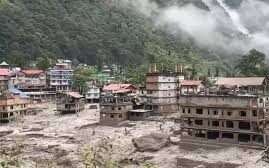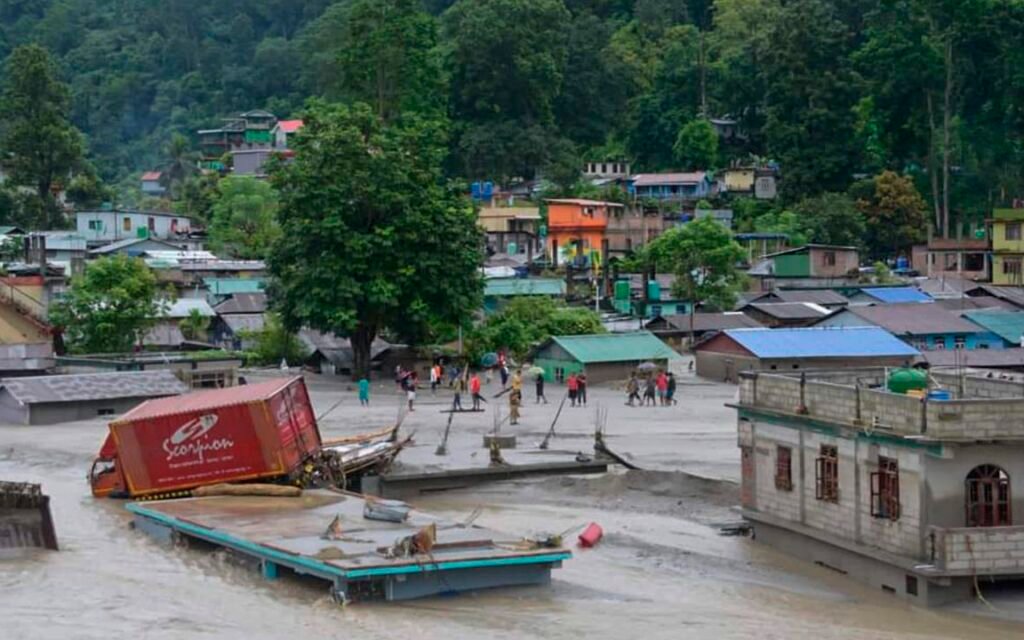Table of Contents
- Introduction (Sikkim Flood 2023)
- The Causes of the Flood
- The Impact of the Flood
- The Government’s Response
- The Future of Sikkim
- Conclusion
Introduction (Sikkim Flood 2023)
Sikkim Flood 2023, a small northeastern state in India, was devastated by a flash flood on October 5, 2023. The flood was triggered by the outburst of a glacial lake, the South Lhonak Lake, which is located in the north of the state. The floodwaters caused widespread damage, washing away houses, bridges, and roads. At least 40 people have been killed and dozens more are missing.
The Sikkim Flood 2023 also had a significant impact on Sikkim’s economy, which is largely dependent on tourism and agriculture. Many tourist destinations have been damaged or destroyed, and thousands of acres of farmland have been washed away. The state government has estimated that the total damage caused by the flood is in the billions of rupees.
The Causes of the Flood
The causes of sikkim flood 2023 are still being investigated, but it is believed that a combination of factors contributed to the disaster. Climate change is likely to have played a role, as it is melting glaciers and increasing the risk of glacial lake outbursts. Other factors that may have contributed to the flood include heavy rainfall and poor dam construction practices.
The Impact of the Flood

The Sikkim flood 2023 has had a devastating impact on the people entirely. Many people have lost their homes, livelihoods, and loved ones. The state government is working to provide relief and rehabilitation to those affected by the flood, but the task is daunting.
In addition to the human impact, the flood has also had a significant impact on Sikkim’s environment. The floodwaters have washed away forests and damaged fragile ecosystems. The state government is working to restore the environment, but it will take many years for the damage to be repaired.
The Government’s Response
The central and state governments have responded to the flood by providing relief and rehabilitation to those affected. The Indian Army and Air Force have also been involved in the rescue and relief operations.
The state government has announced a number of measures to help those affected by the flood, including financial assistance, temporary housing, and food and medical supplies. The government has also set up a relief fund to help with the reconstruction efforts.
The central government has also provided assistance to Sikkim in the aftermath of the flood. The Prime Minister of India has visited the state and announced a number of relief measures, including financial assistance and the deployment of central forces to help with the relief and reconstruction efforts.
The Future of Sikkim
The Sikkim flood 2023 has been a major setback, but the state is resilient and is determined to recover. The state government has announced a number of measures to rebuild the state, including the construction of new dams and bridges, the repair of damaged roads and infrastructure, and the restoration of forests and other ecosystems.
The state government is also working to promote sustainable development in Sikkim. This includes investing in renewable energy, developing eco-friendly tourism, and promoting sustainable agriculture practices.

Conclusion
The Sikkim flood of 2023 was a devastating event, but it has also brought out the resilience and spirit of the people of Sikkim. The state government is working to rebuild the state and promote sustainable development. With the support of the central government and the international community, Sikkim can emerge from this tragedy stronger than before.
Additional Information
In addition to the above, here are some specific challenges and opportunities that Sikkim faces in the aftermath of the flood:
Challenges:
- Climate change: Sikkim is one of the most vulnerable states in India to climate change, before the Sikkim flood 2023 the state was experiencing rising temperatures, melting glaciers, and more extreme weather events. These changes are increasing the risk of natural disasters such as floods, landslides, and droughts.
- Infrastructure: Sikkim’s infrastructure is underdeveloped and vulnerable to damage from natural disasters. The state needs to invest in improving its roads, bridges, dams, and other infrastructure.
- Economy: Sikkim’s economy is largely dependent on tourism and agriculture. The flood has had a significant impact on both of these sectors. The state needs to diversify its economy and create new jobs.
Opportunities:

Image Credit Freepik
- Renewable energy: Post Sikkim flood 2023 the state now has a lot of potential for renewable energy development, such as hydropower, solar power, and wind power. The state can develop its renewable energy resources to meet its own energy needs and export electricity to other states.
- Eco-tourism: Sikkim is a popular tourist destination due to its natural beauty and cultural heritage. The state can develop eco-tourism to promote sustainable development and create new jobs.
- Agriculture: Sikkim has a lot of potential for sustainable agriculture. The state can promote the cultivation of high-value
Thank you for visiting our post “Sikkim Flood 2023 The Natural Calamity”
READ MORE
THE REASONS VISITING NORTH EAST INDIA (2023) A COMPREHENSIVE GUIDE
THE BENEFITS OF TRAVELING AND EXPANDING YOUR HORIZONS: COMPREHENSIVE GUIDE 2023
Click Here for similar stories!
